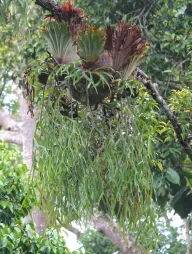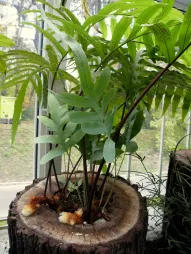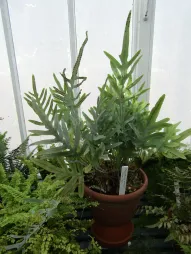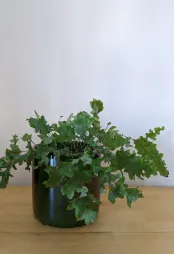Platycerium bifurcatum, the elkhorn fern
Before you fall for this mini elkhorn fern in the garden center, think again! With the right care, Platycerium bifurcatum can grow larger than your Boston fern or Pothos. And it can live for up to 60 years.
How to recognize Platycerium bifurcatum, the elkhorn fern?
Platycerium bifurcatum is an epiphytic fern with a dense, spreading habit. Smaller than platycerium coronarium, it reaches a meter in height and two meters in width. Its fronds can be upright or drooping.
The elkhorn fern has two types of fleshy fronds. The flat, oblong sterile ones are located at the base of the plant. Initially green, they turn brown and harden to form a shield, covering the host pot or tree. They retain water, dead leaves and insects to support the plant.
Fertile fronds emerge at the heart of this nest, carried by a long petiole. They are bifurcated and multilobed, like elk antlers. Green, they are coated with a bloom that gives them a silvery sheen.
Platycerium bifurcatum produces neither flowers nor fruit. It reproduces by producing brown spores on the underside of fertile fronds.
Elkhorn fern is non-toxic to animals and humans.
Our maintenance tips
Pay particular attention to the choice of container or support. After a few repottings, your Elkhorn fern will cover it with its fronds. You won't be able to change pots.
Watering
You need to let the substrate dry out between waterings. The best way to tell if your plant is thirsty is to observe it: when the fronds droop, it's time to give it a drink.
Fill a basin with rainwater at room temperature. Immerse the support (basket, wooden board) and soak for at least 15 minutes during the growth phase. During the resting period, a two-minute soaking is sufficient. Before returning your Elkhorn fern to its place, make sure any excess water has drained off.
Green fronds are covered in bloom. Make sure you don't touch them while watering! You risk damaging them.
Spray
Spray foliage with water at room temperature. Do not use tap water. It is often too hard and leaves marks on the leaves.
Fogging temporarily increases humidity and combats the appearance of parasites.
Repotting
In spring, transfer your Platycerium bifurcatum to a larger pot, so that it can continue to grow.
To repot your Elkhorn fern, you'll need an openwork orchid basket. Line the bottom and sides with blond peat or sphagnum moss. Pour in a bed of potting soil for epiphytic orchids.
Meanwhile, soak the rootball of your Platycerium bifurcatum. When damp, place the plant in the basket. You can add some sphagnum moss around the edges to help the plant stand upright in the center of the container.
Water and allow excess to drain away.
Fertilization
You can stimulate the development of your plant during its growth phase, in spring and summer, with fertilizer.
If you want to speed up your plant's growth, feed your Platycerium bifurcatum with a green plant fertilizer.
Cutting
Cutting is carried out during the strong growth phase, generally in spring and early summer.
Separate the shoots using a clean, sharp knife, without damaging the mother plant. Be sure to remove at least one frond and some roots.
Obtain an openwork basket, such as an orchid basket. Line it with blond peat moss. Add a bed of substrate for epiphytic orchids at the bottom. Plant your Elkhorn fern and pour in a layer of substrate.
Water generously and leave the rootball to drain before replacing the container.
Disease / Threat
Information
| Family | Polypodiaceae - Polypodiaceae |
| Type | Platycerium - Platycerium |
| Species | Elkhorn fern - Platycerium bifurcatum |
| Lifecycle | Perennial |
| Foliage | Evergreen |
| Exposure | |
| Substrat | |
| Planting method |
In pots |
| Categories | |
| Tag |
Large pot |
| Origins |
Southeast Asia Australia |
| Hardiness (USDA) | 11b |
| Leaf color |
|
Discover plants from the same family

Platycerium coronarium
Discover

Golden polypod
Discover

Phlebodium aureum 'Blue Star
Discover

Phlebodium aureum 'Davana
Discover
















